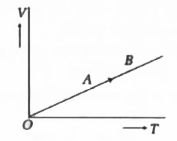कार्बन, सिलिकॉन और जर्मेनियम, प्रत्येक में चार संयोजक इलेक्ट्रॉन हैं। इनकी विशेषता ऊर्जा बैण्ड अन्तराल द्वारा पृथक्कृत संयोजकता और चालन बैण्ड द्वारा दी गई हैं, जो क्रमशः (Eg)Si तथा (Eg)C के बराबर हैं। निम्नलिखित में से कौन-सा कथन सत्य है? 1) (Eg)Si<(Eg)Ge<(Eg)C 2) (Eg)C<(Eg)Ge>(Eg)Si 3) (Eg)C>(Eg)Si>(Eg)Ge 4) (Eg)C=(Eg)Si=(Eg)Ge
(Eg)Si<(Eg)Ge<(Eg)C
(Eg)C<(Eg)Ge>(Eg)Si
(Eg)C>(Eg)Si>(Eg)Ge
(Eg)C=(Eg)Si=(Eg)Ge
The correct Answer is:C
कार्बन के लिए ऊर्जा बैण्ड अन्तराल उच्च होता है तथा सिलिकॉन के लिए कम एवं जर्मेनियम के लिए न्यूनतम होता है।
Topper's Solved these Questions
- BOOK - NEET PREVIOUS YEARCHAPTER - अर्द्धचालक इलेक्ट्रॉनिकी ; पदार्थ युक्तियाँ तथा सरल परिपथ EXERCISE - NCERT व NCERT Exemplar के प्रश्न (NCERT Exemplar)14videos
अर्द्धचालक इलेक्ट्रॉनिकी ; पदार्थ युक्तियाँ तथा सरल परिपथ
- BOOK - NEET PREVIOUS YEARCHAPTER - अर्द्धचालक इलेक्ट्रॉनिकी ; पदार्थ युक्तियाँ तथा सरल परिपथ EXERCISE - Special Format वाले Objective प्रश्न (V. एक से अधिक सही ऑप्शन वाले प्रश्न) More than One Correct Option7videos
अर्द्धचालक इलेक्ट्रॉनिकी ; पदार्थ युक्तियाँ तथा सरल परिपथ
- BOOK - NEET PREVIOUS YEARCHAPTER - अणुगति सिद्धान्तEXERCISE - MCQs24videos
अणुगति सिद्धान्त
- BOOK - NEET PREVIOUS YEARCHAPTER - अर्द्धचालक इलेक्ट्रोनिकी पदार्थ , युक्तियाँ ,सरल परिपथ तथा संचार तंत्र EXERCISE - बहुविकल्पीय प्रश्न104videos
अर्द्धचालक इलेक्ट्रोनिकी पदार्थ , युक्तियाँ ,सरल परिपथ तथा संचार तंत्र
Similar Questions
ताप में वृद्धि से किसी अर्द्धचालक की चालकता में वृद्धि का कारण यह है कि मुक्त धारावाहकों का-
01:51View Solutionयदि अर्द्धचालक का जालक नियतांक घट रहा है, तो निम्न में से कौन-सा कथन असत्य है?
 View Solution
View Solutionकिसी एकपरमाणुक गैस के आयतन (V) में ताप (T) के साथ विचरण निम्न ग्राफ के अनुसार होता है। अवस्था A से अवस्था B तक जाने की प्रक्रिया में गैस द्वारा किए गए कार्य और इसके द्वारा अवशोषित ऊष्मा का अनुपात है
 02:12View Solution
02:12View Solutionp-n संधि अग्न अभिनत कहलाएगी
04:48View SolutionCarbon, silicon and germanium atoms have four valence electrons each. Their valence and conduction bands are separated by energy band gaps represented by (Eg)C,(Eg)Si and (Eg)Ge, respectively. Which one of the following relationship is true in their case?
02:46View Solutioneg orbitals include
View SolutionCarbon, silicon and germanium have four valence electrons each. These are characterised by valence and conduction bands separated by energy band gap respectively equal to ( E _(g))_(c ) , ( E_(g))_(Si ) and ( E_(g ))_(G e ) .Which of the following statements is true ? (a) (E_(g))_(Si) lt ( E_(g))_(Ge ) lt ( E_(g))_(C ) (b) ( E_(g))_(C ) lt ( E_(g))_(Ge ) gt (E_(g))_(Si) (c ) (E_(g))_(C ) gt ( E_(g))_(SI) gt ( E_(g))_(Ge ) (d) ( E_(g))_(C ) = ( E_(g))_(Si) = ( E_(g))_(Ge )
06:08View SolutionCarbon silicon and germanium have four valence electrons each. These are characterised by valence and conduction bands separated by energy band gap respectively equal to (E_(g))_(C), (E_(g))_(Si) " ""and" " "(E_(g))_(Ge) which of the following statements is true?
View Solutione_(g) orbitals are proposed in
01:51View Solutione_(g) orbitals consist of
01:51View Solutionकार्बन , सिलिकन और जर्मेनियम , प्रत्येक में चार संयोजक इलेक्ट्रान है । इनकी संयोजकता और चालन पट्टियां क्रमशः (Eg).C,(Eg).Siतथा(Eg).Ge ऊर्जा पट्टी अंतराल से पृथक्कृत है । निम्नलिखित में कौन - सा प्रकथन सत्य है ?
01:50View Solutioneg कक्षक कौनसे होते है?
05:11View SolutionCarbon, silicon and germanium atoms have four valence electrons each. Their valence and conduction bands are separated by energy band gaps represented by (Eg)C,(Eg)Si and (Eg)Ge, respectively. Which one of the following relationship is true in their case?
View SolutionCarbon, silicon and germanium atoms have four valence electrons each. Their valence and conduction bands are separated by energy band gaps represented by (Eg)C,(Eg)Si and (Eg)Ge, respectively. Which one of the following relationship is true in their case?
04:21View SolutionCarbon silicon and germanium have four valence electrons each these are characterised by valence and conduction bands separated by energy band gap respectively equal to which of the following statement is true
(a) (Eg)Si<(Eg)Ge<(Eg)c
(b)(Eg)c<(Eg)Ge<(Eg)Si
(c )(Eg)c>(Eg)Si>(Eg)Ge
(d)(Eg)c=(Eg)si=(Eg)Ge02:11View SolutionCarbon, silicon and germanium have four valence electrons each . These are characterised by valence and conduction bands separated by energy band gap respectively equal to (Eg)C,(Eg)Si and (Eg)Ge . Which of the following statements is true ?
02:16View Solution

